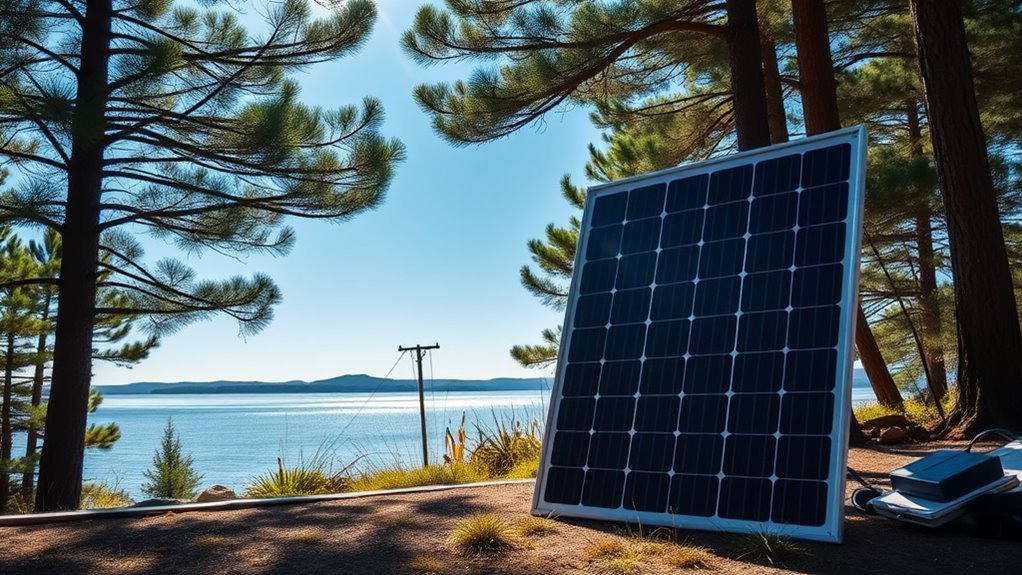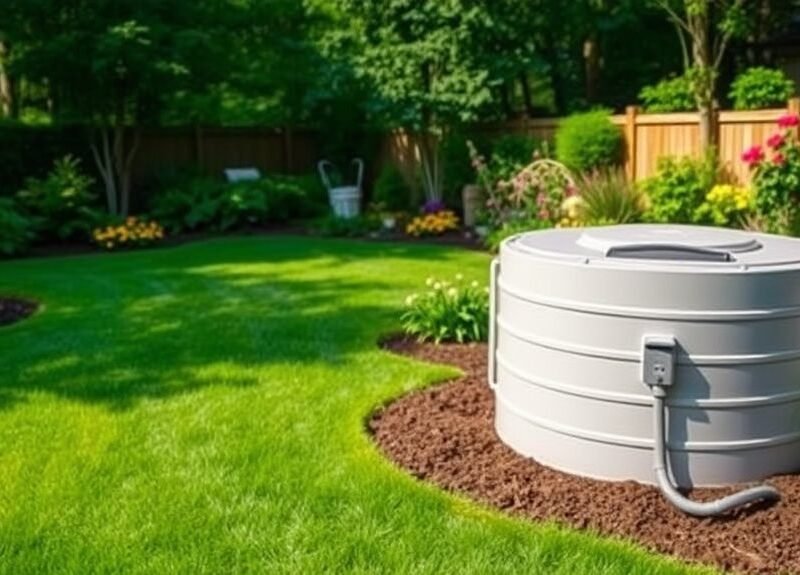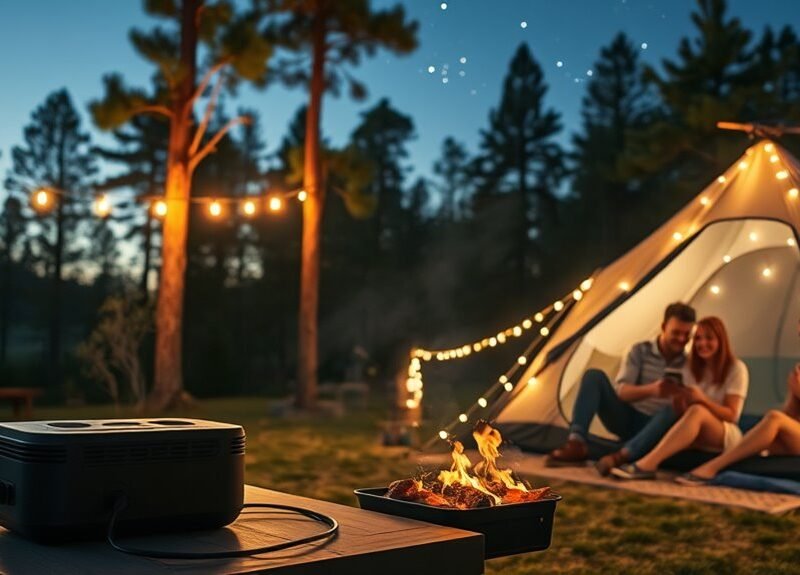Setting up portable solar power for your camping trip involves selecting the right equipment and understanding solar principles. Start with solar panels, batteries, and an inverter that meets your power needs. Position panels at a 30-45 degree angle for ideal sunlight exposure, ensuring no shadows obstruct them. Connect your panels to a suitable battery using secure wiring and charge controllers. Regularly check connections and monitor battery performance. Consider eco-friendly camping practices to minimize your environmental impact. With these steps, you're on your way to a sustainable adventure. Discover more tips to maximize your solar efficiency and enhance your camping experience.
Key Takeaways
- Assess your daily power needs to determine the size and number of solar panels required for your camping trip.
- Choose lightweight, durable solar panels, such as monocrystalline, for efficient energy capture and transport.
- Utilize a suitable battery system with enough capacity to store energy for use during cloudy days or nighttime.
- Position solar panels at a 30-45 degree angle, ensuring they have unobstructed sunlight throughout the day.
- Regularly monitor and maintain your solar setup, cleaning panels and checking connections to optimize performance.
Understanding Solar Power Basics
Understanding the basics of solar power is vital for making the most of your camping experience. Solar energy harnesses sunlight to generate electricity, providing a sustainable power source for off-grid living. By converting sunlight into usable energy, you can power devices like lights, chargers, and small appliances, enhancing your outdoor adventure.
Solar panels, the core components of this system, capture sunlight and convert it into direct current (DC) electricity. This electricity can then be stored in batteries for later use, ensuring you have power even when the sun isn't shining. Familiarizing yourself with the efficiency ratings of solar panels can help you evaluate their performance in different conditions.
In off-grid living, understanding energy consumption is essential. You'll want to assess the wattage of your devices and estimate how much power you'll need daily. Combining this knowledge with your solar panel output will help you determine the right setup for your camping trip.
Finally, remember that the location and angle of your solar panels can greatly affect their efficiency. Position them to maximize exposure to sunlight, so you can make the most of your solar energy while enjoying the great outdoors.
Choosing the Right Solar Equipment
When choosing the right solar equipment for camping, you need to take into account the types of solar panels, battery storage options, and the inverter you'll use.
Each component plays an essential role in ensuring you have a reliable power source.
Understanding these factors will help you maximize your solar setup for outdoor adventures.
Solar Panel Types
Choosing the right solar panel type for your camping trip can greatly impact your energy needs. When selecting solar panels, you should consider factors like efficiency, weight, and cost.
The two main types of solar panels you'll encounter are monocrystalline and polycrystalline panels. Here's a quick overview to help you decide:
- Monocrystalline Panels: Known for their high efficiency and space-saving design, these panels are made from single crystal structures. They tend to perform better in low-light conditions, making them ideal for shaded camping spots.
- Polycrystalline Panels: These panels are made from multiple crystal structures and are generally less expensive than monocrystalline panels. However, they're slightly less efficient and occupy more space, so be mindful of your setup.
- Weight: Consider the weight of the panels, especially if you're backpacking. Lighter panels are easier to transport, but they may come at a higher cost.
- Durability: Look for panels with a robust design and a good warranty. Camping can be harsh on equipment, so durability is essential.
Battery Storage Options
For a successful camping trip powered by solar energy, selecting the right battery storage option is essential.
You'll want to focus on battery capacity, which determines how much energy your system can store for use later. Consider your power needs by calculating the total watt-hours required for your devices. Aim for a battery that can meet or exceed this capacity to guarantee you don't run out of power during your trip.
Next, explore the various charging options available. Lithium-ion batteries are popular due to their lightweight design and efficiency, but they can be pricier. Lead-acid batteries, while heavier, are often more affordable and have a proven track record.
Make sure you choose a battery that can be charged using your solar panels, either through a direct connection or via a solar charge controller.
It's also wise to think about the battery's depth of discharge (DoD) and cycle life, as these factors affect longevity and performance.
Inverter Selection Guide
After determining your battery storage options, the next step is selecting the right inverter for your solar power system.
Inverters convert the DC electricity generated by your solar panels into usable AC power for your devices. Choosing the appropriate inverter types and ensuring high inverter efficiency are essential for maximizing your solar setup's performance.
Here's a quick guide to help you select the right inverter:
- Determine Power Requirements: Calculate the total wattage needed by your devices to select an inverter that can handle the load.
- Choose Inverter Type: Decide between pure sine wave, modified sine wave, or grid-tie inverters based on the type of devices you'll be using. Pure sine wave inverters are often recommended for sensitive electronics.
- Check Inverter Efficiency: Look for inverters with an efficiency rating above 90%. Higher efficiency means less energy loss during conversion.
- Consider Portability: If you're camping, opt for a lightweight inverter that's easy to transport while still meeting your power needs.
Setting Up Your Solar System
To set up your solar system, start by choosing the right solar panels that meet your energy needs.
Next, connect the panels to your battery system, ensuring all connections are secure.
Finally, position your setup to maximize sunlight exposure, optimizing power generation throughout the day.
Choosing Solar Panels
When selecting solar panels for your camping setup, it's important to understand your energy needs and the environment you'll be in.
Start by evaluating how much power you'll require to run your devices. Consider factors like the number of gadgets and their power consumption.
Here are four key factors to help you choose the right solar panels:
- Solar Panel Efficiency: Look for panels with high efficiency ratings, as they convert more sunlight into usable energy, maximizing your output in limited space.
- Portability: Opt for lightweight and compact portable solar kits that are easy to transport and set up, especially if you're hiking or traveling by vehicle.
- Durability: Choose panels made from robust materials that can withstand outdoor conditions, including moisture and temperature variations.
- Compatibility: Confirm the solar panels you select are compatible with your existing system, including batteries and inverters, for seamless integration.
Connecting to Battery
Connecting your solar power system to a battery is essential for storing energy generated during the day for use at night or during cloudy conditions. To begin, verify you have the right battery type; deep-cycle batteries are ideal for solar applications due to their ability to discharge and recharge efficiently.
Next, make the necessary battery connections. Use appropriate gauge wiring to connect your solar panels to the battery's positive and negative terminals, confirming a secure fit to prevent any loose connections.
Additionally, consider installing a charge controller between the solar panels and the battery. This device regulates the flow of electricity, preventing overcharging and optimizing power management.
Once connected, regularly monitor the battery's voltage and state of charge. This practice not only prolongs the battery's lifespan but also guarantees reliable power availability during your camping trip.
If you're using multiple batteries, make sure they're connected in parallel for increased capacity without altering the voltage. This setup maximizes your energy storage and enhances your overall power management.
With these connections in place, you'll have a robust solar power system ready to support all your camping needs.
Positioning for Sunlight
Positioning your solar panels for maximum sunlight exposure is crucial for optimizing energy generation during your camping trip. To achieve this, you'll need to take into account sunlight angles and effective shade management. Here are some key steps to follow:
- Assess Sunlight Patterns: Observe the sun's trajectory throughout the day. Knowing when and where sunlight is most direct will help you position your panels effectively.
- Angle Your Panels: Adjust the tilt of your solar panels based on the sun's angle. A tilt of 30-45 degrees is often ideal for maximizing exposure, depending on your geographic location.
- Eliminate Shadows: Identify and remove potential sources of shade, such as trees or tents. Make sure your panels are placed in a clear area to avoid interruptions in sunlight.
- Use Adjustable Mounts: Invest in adjustable mounts or stands that allow you to reposition your panels easily as the sun moves. This flexibility enhances energy capture throughout the day.
Optimizing Solar Power Usage
Optimizing solar power usage during camping trips requires strategic planning and smart equipment choices. Start by evaluating your energy needs. Determine which devices are essential and their power requirements. This helps in selecting the right solar panel size and capacity, maximizing solar efficiency.
Next, use energy conservation techniques. Turn off devices when not in use and consider using energy-efficient appliances, which consume less power. You can also invest in a solar charge controller to regulate the voltage and current coming from your panels, preventing overcharging and enhancing battery lifespan.
Position your solar panels for maximum sunlight exposure throughout the day. Make sure they're placed at the correct angle based on the sun's path, and periodically adjust them to capture changing light conditions.
Utilizing a battery storage system can also optimize usage. Store excess energy generated during the day for use at night, ensuring you have power when you need it.
Lastly, monitor your energy consumption regularly. Keeping track allows you to adjust your usage habits and equipment choices, guaranteeing you're making the most of your solar setup while enjoying your camping experience.
Maintenance Tips for Solar Gear
Proper maintenance of your solar gear is essential for guaranteeing its longevity and ideal performance during camping trips. By following these maintenance tips, you can keep your equipment in top shape, ready to provide you with renewable energy.
1. Regular Cleaning: Use soft cloths and mild cleaning solutions to remove dust and debris from solar panels. This enhances their efficiency.
Avoid abrasive materials that could scratch the surface.
2. Inspect Connections: Frequently check all connections and cables for wear and tear. Loose or damaged connections can lead to power loss.
Guarantee everything is securely attached before use.
3. Monitor Performance: Keep an eye on the output levels of your solar gear. If you notice a significant drop in performance, it might be time to investigate further.
4. Store Properly: When not in use, store your solar gear in a cool, dry place.
Avoid extreme temperatures and humidity, which can damage components.
Eco-Friendly Camping Practices
When you head out into nature, adopting eco-friendly camping practices can greatly reduce your environmental impact. Start by choosing eco-friendly gear, such as biodegradable soaps, reusable utensils, and solar-powered devices. This not only minimizes waste but also guarantees you're using sustainable resources.
Plan your trips carefully to minimize your carbon footprint. Carpool with friends or utilize public transportation to reach your destination. Once you're there, stick to established trails to prevent soil erosion and protect local flora. Leave no trace by packing out all waste, including food scraps and personal items.
Water conservation is essential; use a refillable water bottle and treat water from natural sources instead of bringing bottled water. When cooking, opt for lightweight, compact cooking gear that requires less fuel, and consider bringing a portable solar oven for energy-efficient meal prep.
Finally, educate yourself on local wildlife and ecosystems. Avoid disturbing habitats and know which plants are native to the area. By incorporating these sustainable practices, you'll contribute to preserving the beauty of nature for future generations while enhancing your camping experience.
Conclusion
By harnessing solar power for your camping trip, you not only enjoy the convenience of electricity but also contribute to a more sustainable environment. With the right equipment and setup, you can maximize your power usage while minimizing your ecological footprint. Isn't it great to know you can power your adventures without harming nature? Keep your gear maintained and follow eco-friendly practices, and you'll guarantee your solar system serves you well on many more trips to come.


